Self-Medicating in America
Exploring Habits of Self-Medication With Alcohol and Illicit Substances
Everyone is familiar with the fast-talking, seemingly slurred words at the end of commercials: dizziness, weakness, loss of coordination, nausea, vomiting, insomnia, inability to fight infections, depression, suicidal thoughts, and death. Nowadays, it seems like the list of prescription side effects is longer than the description, dosage, and active ingredients combined. Still, 55% of Americans regularly take prescription drugs. But with both minor and severe complications, along with the increased risk of abuse and addiction, many people are fearful of Big Pharma and everything they produce.
This fear can often turn people to self-medicate rather than receive a proper diagnosis and treatment. So how many people are forgoing professional advice and choosing to self-medicate? We surveyed over 1,000 people to discover the prevalence of self-medicating, the most used substances, and the biggest issues respondents treat. Keep reading to see what we learned.
Addressing Issues
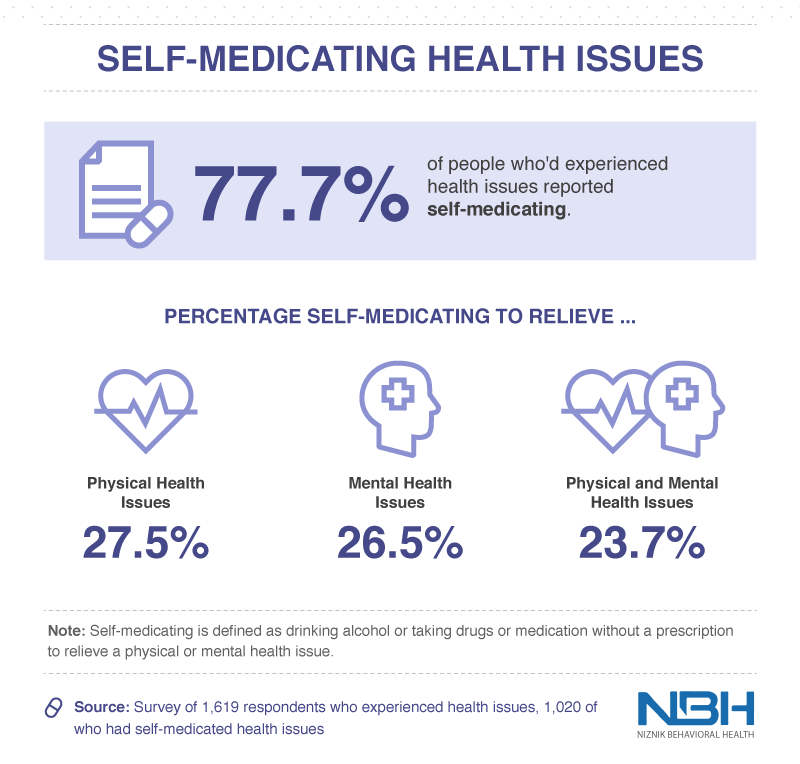
While most may associate self-medicating with the use of drugs or alcohol, there are various forms of self-medication that people might not recognize. While alcohol, psychostimulants, cannabis, and opioids are certainly used to self-medicate, so too are food and caffeine. Considering eating food is necessary to live and drinking coffee is a part of 64% of Americans’ days, the signs of self-medicating with food and caffeine can be difficult to recognize.
Focusing on self-medicating with drugs and alcohol, however, 78% of people who experienced health issues had self-medicated in response.The issues being treated, though, were pretty evenly split. While 28% self-medicated to treat physical health concerns, 27% sought to treat mental health issues, and 24% attempted to treat both.
Self-Medicating Substances
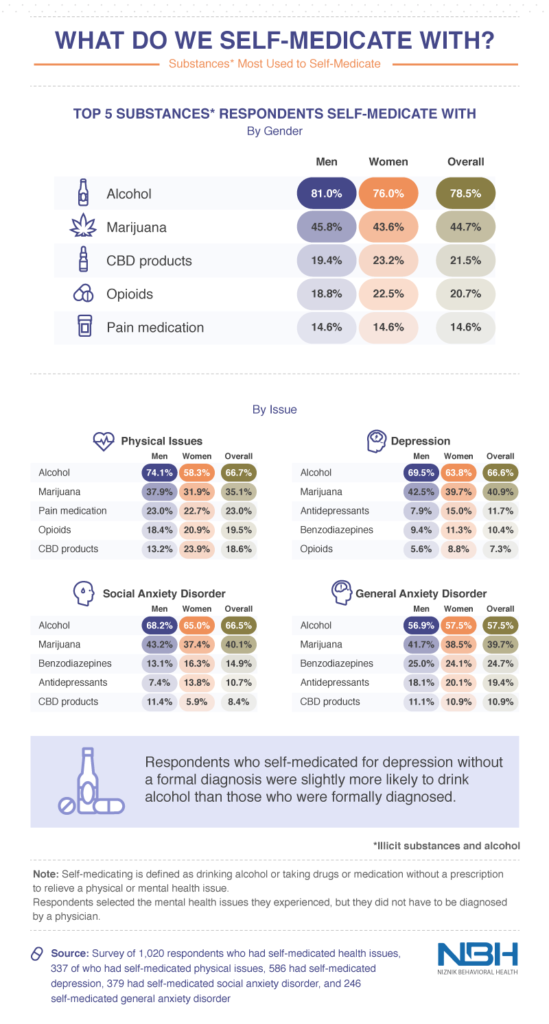
So what substances are the most used to self-medicate? Both men and women used alcohol to treat their ailments more than any other substance, but men were more likely to do so. While 81% of men had used alcohol to self-medicate, 76% of women did the same. Marijuana was also popular for both genders, but women were more likely to use CBD products and opioids to self-medicate compared to their male counterparts.

Request a Call to Speak to a Coordinator Today.
This is likely due to women’s increased likelihood of using CBD products and opioids to treat physical issues. Compared to 13.2% and 18.4% of men self-medicating with CBD products and opioids, respectively, nearly 24% and 21% of women reported using CBD products and opioids to treat physical issues.Women were also more likely to use opioids to treat depression. On the other hand, men were more likely to resort to marijuana to treat physical issues, depression, social anxiety disorder, and general anxiety disorder.
Studies show marijuana can be used medically to treat various physical ailments, including pain, muscle tremors, nausea, and weight loss, but the research is lacking when it comes to using it to treat mental illness. Of studies conducted, marijuana has been shown to decrease symptoms of PTSD and help increase appetite in those with anorexia, but the drug’s ability to increase symptoms of anxiety and depression have turned doctors away from using it as a treatment. However, for those self-medicating, the relaxing and euphoric effects brought on by marijuana may lead users to think the drug is helping their issues. But for now, the benefits are strictly anecdotal.
Doubling Up Doses
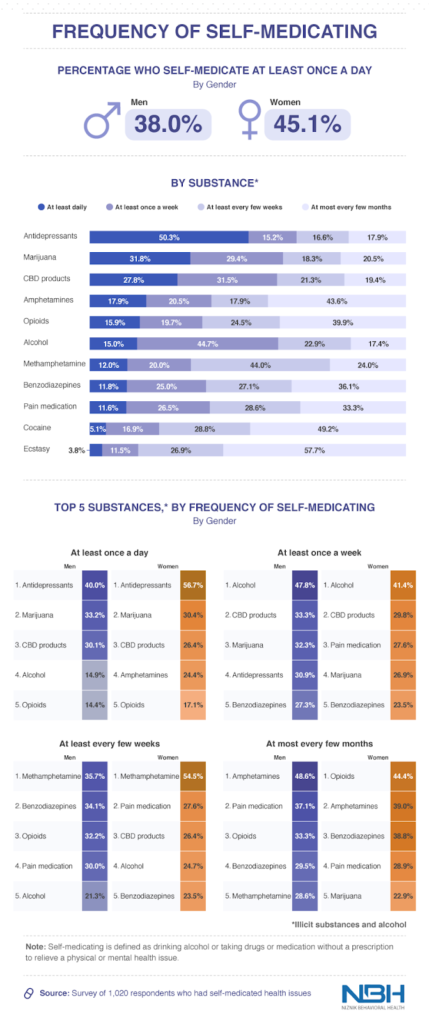
One of the dangers of self-medicating is a lack of knowledge about dosage. How much medicine to take and when to take it is usually written on a prescription. But when people treat themselves, what’s the limit?
Thirty-eight percent of men and 45% of women self-medicated at least once a day. Antidepressants were the drug of choice for those self-medicating once or more a day – 50.3% of respondents used them daily, while almost 18% took antidepressants once every few months or less. Marijuana was also popular among those self-medicating at least once a day. Nearly 32% of people who self-medicated used marijuana daily, while almost 30% used it at least once a week.
While there are numerous differences between men and women regarding the risk of substance abuse and recovery outcomes, the frequency of their use also differs based on the substance. Women were more likely than men to use antidepressants at least once a day, while men tended to use marijuana and CBD products daily. Self-medicating once a week to a few times per week was also more common among men – compared to women, men were more likely to drink alcohol and use CBD products, marijuana, and benzodiazepines.

Request a Call to Speak to a Coordinator Today.
Keeping the Doctor Away
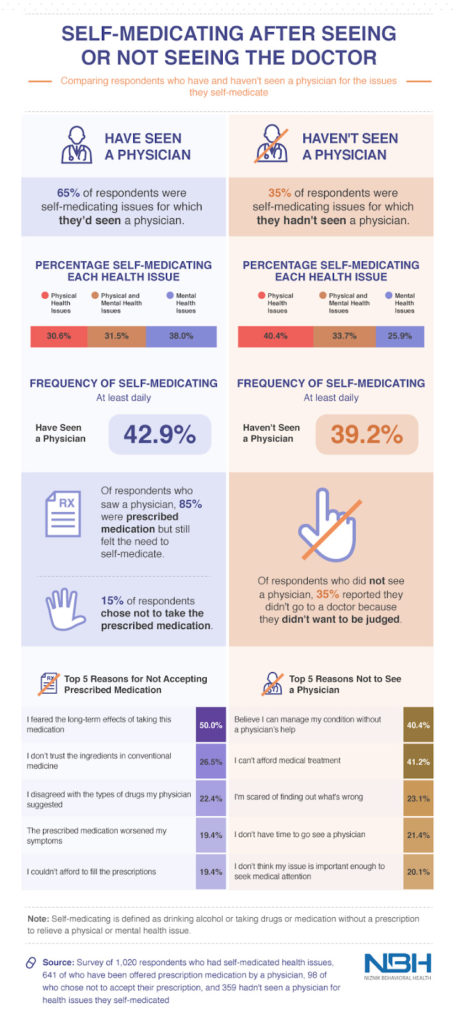
Making a yearly trip to the doctor has been up for debate for some time. While numerous studies have found wellness visits to be a waste of time and money, symptoms resulting in self-medicating indicate the need for a trip to the doctor. Surprisingly, 65% of respondents were self-medicating issues they had seen a physician for.
The majority of these issues were mental health-related – those self-medicating physical health issues were significantly more likely to have not seen a physician. However, visiting a doctor didn’t have much impact on the frequency of use. Nearly 43% of those who had seen a physician self-medicated at least once a day, while around 40% of those who hadn’t seen a physician did as well.
A trip to the doctor doesn’t prevent self-medication, though. Of the 85% of respondents who saw a physician and were prescribed medication, 15% chose not to take it. Their reasoning? Fifty percent chose not to accept the prescription because they feared the long-term effects of taking it, and over 26% didn’t trust the ingredients.
However, for those forgoing a doctor visit altogether, their reasoning wasn’t rooted in fear or distrust. Rather, 41% simply couldn’t afford it. That’s not much of a surprise considering the cost of health care has increased exponentially in the last 60 years. While health care in 1960 cost each person an average of just $146 yearly, the price reached $10,345 per person in 2016 and is expected to near an annual average of $15,000 by 2023. Aside from affordability, 40% believed they could manage their condition without a physician’s help.
Mental Health and Self-Medicating
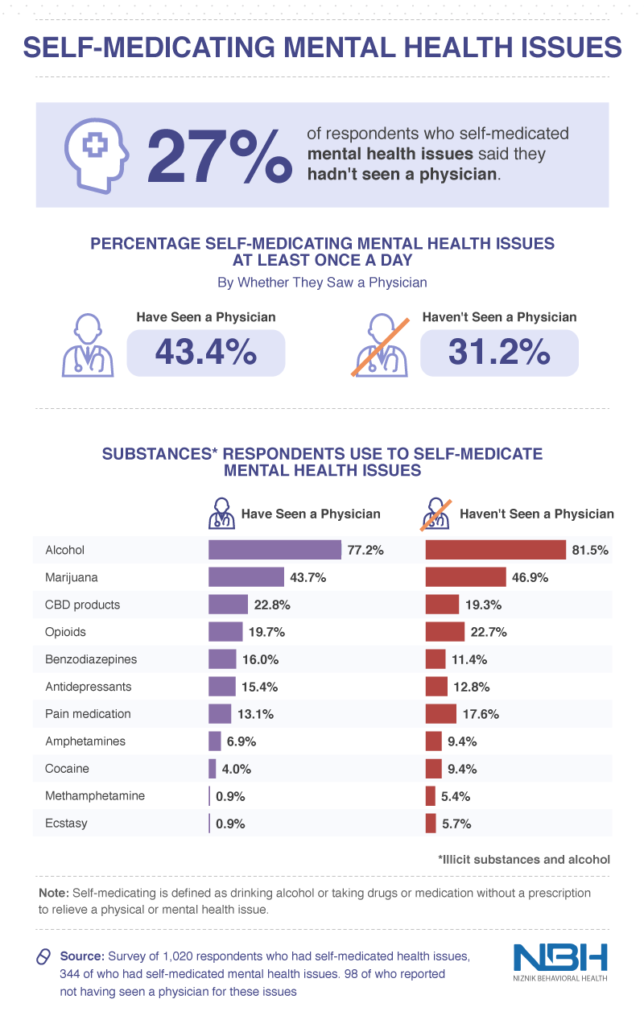
Self-medicating mental health issues is a common practice that tends only to ease symptoms temporarily. In fact, using substances to treat mental health issues often leads to a worsening of the issues. When other mental health disorders are comorbid with a substance use disorder, it can be difficult to tell which one came first. While 31% of respondents self-medicating mental health issues hadn’t seen a physician, those who had were even more likely to self-medicate at least once a day. However, those who chose to self-medicate after seeing a physician were more likely to use CBD products, benzodiazepines, and antidepressants.
The most common substance used to self-medicate mental health issues, though, was alcohol. Over 77% of those who had seen a physician used alcohol to self-medicate, while 81.5% of those who hadn’t seen a physician did the same. Seeing as these substances can cause anxiety and depression, using them to self-medicate is a vicious cycle leading far away from real treatment.
Seeking Sobriety
Going to the doctor is the first step in diagnosing a problem and getting the correct treatment. But when a doctor writes a prescription, it’s up to the patient to fill it and take the medicine accordingly. However, a fear of the side effects and long-term consequences that prescription drugs can bring lead people to treat themselves with alcohol, marijuana, and opioids. Self-medicating doesn’t save users from the side effects and long-term consequences, though. Treating physical and mental health issues with alcohol or other substances can actually worsen symptoms and create an even bigger problem.
Any use of alcohol and other substances increases the risk of dependence and alcohol addiction. As use becomes more frequent and daily functioning without substance use becomes harder, it may be time to seek help. Turning to professionals instead of self-medicating can target the actual issues at play, rather than mask the symptoms. At Niznik Behavioral Health, we are committed to providing you or your loved one with a personalized journey to recovery. From detox to aftercare, we have the support you need to live a sober life. To learn more, visit us online today.
Sources
Methodology and Limitations
For this project, we surveyed 1,619 respondents who experienced health issues. 1,020 of them reported they had self-medicated within the past three years. For the project, self-medicating was defined as drinking alcohol or taking any type of drug or medication without a prescription to relieve a physical or mental health issue. 337 respondents had self-medicated physical issues; 586 had self-medicated depression; 379 had self-medicated a social anxiety disorder; and 246 self-medicated a general anxiety disorder. 93 respondents said they didn’t see a physician for the health issues they self-medicated.
789 respondents had self-medicated using alcohol; 449 used marijuana; 216 used CBD products; 208 used opioids; 147 used non-opioid pain medication; 145 used antidepressants; 144 used benzodiazepines; 78 used amphetamines; 59 used cocaine; 26 used ecstasy; and 25 respondents used methamphetamine.
Respondents could select multiple substances. Heroin and crack were excluded from the list of substances due to insufficient sample sizes.
Forty-eight percent of respondents identified as men, and 52% identified as women. Respondents ranged in age from 18 to 77 with a standard deviation of 11.9. The average age was 37.
Our data rely on self-reporting by the respondents. Issues with self-reported data include but are not limited to: selective memory, telescoping, attribution, and exaggeration. No statistical testing was performed. It is possible that with a greater number of respondents our results would have looked differently.
Fair Use Statement
Do you want to share these findings on self-medicating with alcohol and illicit substances? The graphics and information found on this website are available for noncommercial reuse. Feel free to share them as much as you’d like across the web and on social media, but please make sure to link back to this page. Thank you!

